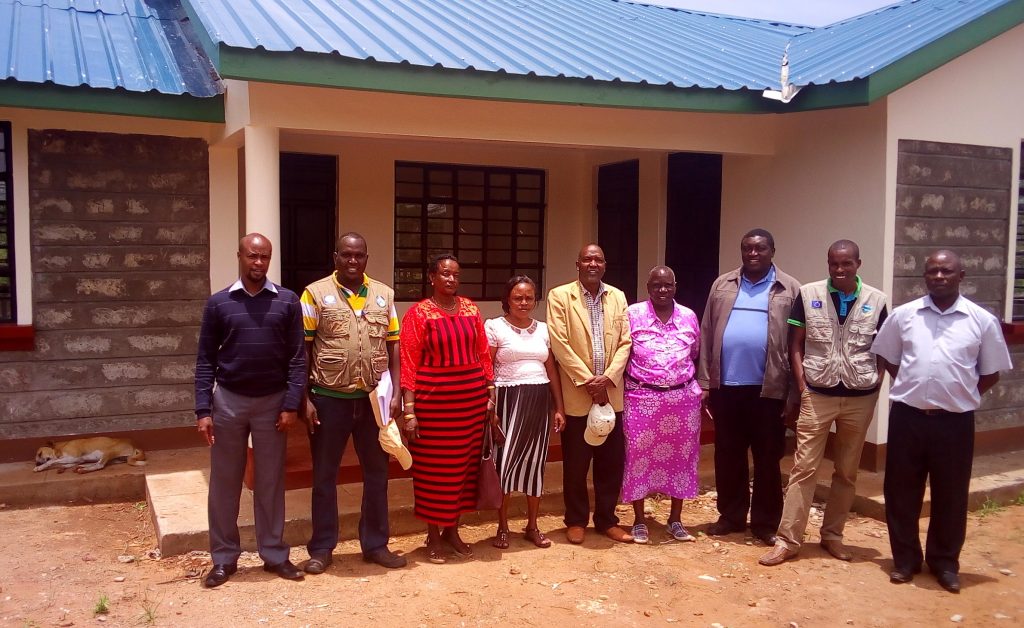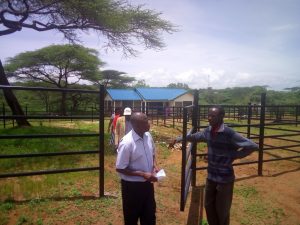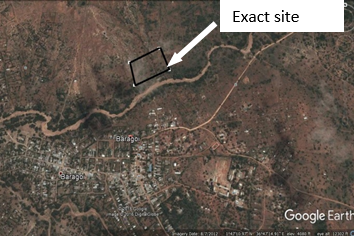Livestock markets in Baragoi were chaotic open air affairs, and it was difficult to coordinate collection of cess and other important checks. This changed following the construction and commissioning of the Baragoi livestock market.
By Geoffrey Lelenguyah and Pat Rupunye
Samburu County is located in the northern part of Kenya, in the former Rift Valley Province. Within this county, about 110 km to the north of Maralal town along the Maralal-Loyangalani road, lies Baragoi. Baragoi town is the headquarters of Samburu North Sub-County.

Exact site of Baragoi livestock market. Photo: RPLRP Kenya.
Livestock is a primary source of livelihood for pastoral communities there. The Baragoi livestock market serves the Turkana, and Samburu pastoral communities living in Baragoi and its environs. Traders from minority groups like Somali and other communities also benefit from using the market.
For a long time, the livestock markets in Baragoi were open air, which made it difficult to coordinate collection of cess and other important checks in the markets. Things changed for the better after the construction and commissioning of the Baragoi livestock market. The market has confinement stalls for camels, cattle, and small stock, in addition to a community area for purchase of food and other commodities. There is an office for livestock officers, and livestock market associations as well.
In addition to the county government, the Regional Pastoral Livelihoods Resilience Project (RPLRP), the National Drought Management Authority (NDMA), Caritas Maralal, and the county special programmes department, were involved in making the new market a reality. NDMA supported the livestock market peace scouting activity, while Caritas assisted in the launch activities by buying a total of 135 small stock to boost restocking by drought affected families. The county special programmes department coordinated peace meetings to strengthen market operations.
RPLRP facilitated community meetings for stakeholder groups, including relevant government departments, to discuss and plan for the construction of the livestock market. Community participation helped to ensure ownership of the process. The market is co-managed by Livestock Marketing Association and the county government, and it is linked with line departments, most notably the livestock department.
Rejuvenation of trade yields peace, higher income and resilience
The new market, which is in the corridor of Samburu North feeder markets, is an economic hub for livestock producers, traders, service providers, and about 6,000 households in the area.

Members of the County steering committee during a visit to the market. Photo: RPLRP Kenya.
The market has contributed to peaceful co-existence of the Samburu and Turkana communities. This has been attributed to increased business interaction, sharing of core management responsibilities and equal representation in market activities such as the sale yard committee and the market peace scouts, which reduced animosity associated with mistrust. The sense of increased trust is also as a result of increased support to operations of peace committees in the Baragoi market. The benefits include increased enrolment due to reopening of several schools like Losurkoi, Kawap, and Marti that were closed due to conflicts.
According to Mr. Paul Leitoro, the Chairman of the Baragoi Livestock Marketing Association (LMA), this facility was meant to be a connector in conflict resolution and peace building for the warring communities. And the communities are already appreciating it.
“It is unbelievable to see our two communities sharing a table at the Livestock Market Committee and in weekly meetings to manage this facility. We hope for a peaceful existence and prosperous livelihood ventures of these two communities moving into the future,” a Baragoi resident, Mrs. Lorot says.
Regular livestock marketing partner meetings have improved information on livestock marketing, formation of livestock marketing structures in Baragoi, and joint collection of cess from livestock sales with the county government. Communities now have an extra income from cess, which has added up to bursaries for school children and food at household level.
With the support of RPLRP, the special programmes department established a county-based monitoring system. This has increased community participation, improved quality of trainings and technical advice, quality assurance, sustainability and ensured linkages. The community structures are able to conduct themselves with reduced supervision. They only call for assistance on technical matters.
The community is more organised with integrated management employed by community structures; peace committees keep vigil for stolen livestock at the market, Water Users Associations are keen on water provision during market day, the LMA ensures sales are well coordinated, and the Animal Health Committee ensure healthy stock in the market. All this results in improved management of resources at community level, increased incomes from livestock sales and understanding of market structures.
Whereas there is no doubt that the livestock market has changed the face of Baragoi, some constraints have persisted. Due to limited funds, important issues such as the link road that is eroded, and the slaughter slab that is quite far from the facility cannot be addressed yet. Part of the problem lies in differing stakeholder strategies and specific bias to sometimes unrelated projects. Although there is already improved capacity among community members, the committees are still weak and high poverty levels mean that the community needs and expectations are more than the project can address.
There have been many lessons learnt during the process of constructing the Baragoi livestock market. Its success is largely attributed to community involvement and widening stakeholder and development partner mobilisation. While capacity building of the LMA and co-sharing are key to strengthening the sustainability component. Another lesson is that community resource mobilisation is easier if incentives that are deemed to bring incomes to the communities are introduced. For example, cess collection at the market is increasing community resources as a result of co-management with revenue department. Therefore, future project designs should be done in such a way that activities bring incomes to communities and create incentives to motivate active community participation. Lastly, partner involvement enriches the implementation process through technical inputs, lesson sharing, and cost sharing of resources.

Baragoi livestock market. Photo: RPLRP Kenya.
The Baragoi livestock market affirms the importance of market access and trade for building resilience, which is captured by Dr. Boreya Lekenit, the County Director of Veterinary Services, Samburu County, when he says: “The current trend in livestock management calls for keeping livestock for business. The county welcomes this facility, as it will help in destocking well before the onset of drought. It will reduce pressure in the dry areas, allowing pastoralists to sell at the right time when they can fetch good prices on the market.”
Mr. Geoffrey Lelenguyah is the Samburu County Project Team Leader and Dr. Pat Rupunye is the Samburu County Project Monitoring and Evaluation Officer both from the RPLRP.

